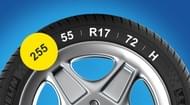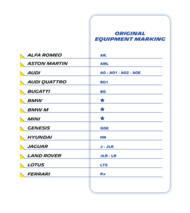
Tips & Advice for Car, SUV & Van tires
What car tires do I need? How to choose the best car tires? If you are asking yourself these questions, our article will help you to consider the important criteria for making the right choice.
The tire size might seem to be the only important factor in deciding which tires to buy. However, as we will see, it is also essential to take into account your driving style and climatic conditions. To help you make the right choice, we'll also mention the European labelling system and provide you with a decision-making tool.
Observe the dimensions indicated by the manufacturer
This is the very first criterion to consider when choosing tires for your car.
As a tire does not have a standard size, you must first identify the tire sizes that are compatible with your vehicle before making your choice according to the other criteria that we will explain below.

Where can I find the tire sizes for my car?
Look at the sidewall of any one of your tires and note the numbers and letters on it.
This information will help you find the tires that fit your car.
Here is an example of the complete dimensions of a tire: 255/55 R17 72H
You can also find the tire sizes in your driver or passenger door
Tire sizes are also listed in your vehicle's owner's manual (which you should find in the glove compartment). These documents usually contain all the information relating to your tire size and specifications, as well as the appropriate tire pressure.

What do these letters and numbers mean?
Tire Width or Section Width : (Example : 255)
Tire width in millimetres is measured from the widest point of a tire’s outer sidewall to the widest point of its inner sidewall.
Aspect Ratio : (Example : 55)
Aspect ratio is the relationship between a tire’s sidewall height and the tire's width. The lower the ratio, the smaller the sidewall height, which means better cornering but a rougher ride.
Construction : (Example : R)
This indicates the tire’s internal construction. They can be R (Radial) like most tires, or D (Diagonal construction) or B (Belted).
Wheel Diameter : (Example : 17)
The number is in inches and indicates the diameter of the wheel on which the tire is designed to fit.
Load Index : (Example : 72)
This indicates how much weight the tire is certified to carry at maximum safe inflation. The numbers refer to a chart that specify the load capacity that the tire can carry.
For example, 72 = 355 kg.
You can find yours in the load Index chart :
Speed Rating chart : (Example : H)
This indicates the maximum safe speed at which a tire is certified to carry a load under specified conditions. Speed ratings range from A (lowest) to Y (highest), with one exception: H falls between U and V.
For example, H = 210 km/h.
To find the maximum speed for your tie, refer to the speed rating chart. Exceeding the lawful speed limit is neither recommended nor endorsed.

High load Capacity tires (HL tires)
HL tires are designed to support the weight of Electric & Hybrid vehicles. They allow to use the same tire size but with higher load carrying capacity.
How to recognize a HL tire? thanks to the HL prefix located at the beginning of the tire size.
What are OE tires?
OE stands for “Original Equipment”, meaning that the tires were approved by your vehicle manufacturer to be fitted as standard on your vehicle.
Some vehicle manufacturers, such as Audi, BMW, Mercedes and others, equip their vehicles with tires that are specifically designed for their brand. These tires have a special OE marking on the sidewall. In this case, MICHELIN recommends replacing the tires on your vehicle with tires with the specific OE marking.
Table of OE markings by vehicle brand:



Choosing car tires according to my use and the conditions of use
Once you have the dimensions, there are three other criteria to consider:
- the climatic conditions in which you drive
- your driving style
- the type of vehicle (electric or thermic)
Climatic conditions :
The other criterion we recommend you take into account when choosing tires for your car is the weather conditions.
How do I choose car tires according to the climate?
- Opt for summer and winter tires if you drive in a mountainous region exposed to severe winter conditions (snow, winter, ice) for several months of the year and temperatures below 7°. If your winter conditions are more severe, see our article "How to choose a winter tire?"

- Opt for all-season tires if you live in a region with less severe winters with occasional snowfall.
- Opt for summer tires all year round if you drive in southern European regions with mild winters (temperature over 7°C, no snow).
Your driving style :
To make sure that you enjoy your drive, look for tires that match the way you like to drive.

If you like a quiet comfortable ride :
Look for tires that specifically mention comfort, smooth ride, or low road noise. Generally speaking, touring tires with lower speed rating (S, T or H ratings on the sidewall) are optimized for more comfort instead of more speed – it's recommended to never fit a tire with the speed rating lower than the one specified by the manufacturer of your vehicle. Also, avoid aggressive tread designs – they may look cool but can generate lots of road noise.
Our MICHELIN Primacy 4⁺, for example, would be a good choice.
If you like to feel every curve :
Look for tires that mention great handling or steering precision. These are often called high-performance tires and have higher speed ratings, meaning that they are optimized to provide better control and a stiffer, more precise ride.
Our MICHELIN Pilot Sport ⁵, for example, is suitable for this style of driving.

The type of vehicle (electric or thermic)
More and more electrically powered vehicles are being introduced to the market. Specific tires are now offered because they are designed for the particular characteristics of these vehicles. Tires with low rolling resistance, for example, are suited to maximise battery range. This applies to our MICHELIN e·Primacy and MICHELIN Pilot Sport EV tires.
Although the MICHELIN e·Primacy is not specifically designed for electric vehicles, it is particularly well suited to them because of its ability to offer low rolling resistance. The MICHELIN Pilot Sport EV is more suitable for "sporty" electric vehicles (e.g. Porsche Taycan, Tesla Model Y, etc.)
TiRE RANGES | FOR WHICH VEHICLES ? | RECOMMENDED FOR |
MICHELIN Primacy ⁴ ⁺ | VW Golf 8, BMW Serie2, Renault Scenic, Peugeot 3008, DS3 CrossBack | Thermic |
MICHELIN e·Primacy | VW Golf 8/e.Golf, Peugeot 3008/3008 Hybrid, Renault Zoe, DS5 Hybrib | Thermic & Electric |
MICHELIN Pilot Sport ⁵ | AUDI A4, MERCEDES C, BMW X3-X5 AMG GLE | Thermic |
MICHELIN Pilot Sport EV | TESLA Model Y, AMG EQS, VOLVO XC 40BEV | Electric |
MICHELIN Pilot Sport ⁴ ˢ | BMM M3, PORSCHE 911(II), AMG CLS53 | Thermic & Electric |
MICHELIN CrossClimate² | VW Golf 8, Peugeot 3008, Renault Kadjar, Volvo XC40, Audi Q3 | Thermic & Electric |
A tool to help you choose the best tires for your car
This tool will help you to choose the best suitable tires from the main MICHELIN offers available, according to the seasonal criteria mentioned above.

For example, if you have a family car such as a Renault Scenic and drive in a mountainous region, you will be alternating summer and winter tires.
Find the right tyre
Enter your vehicle or tyre size
We're searching for your tyre...
Wait few seconds we're processing your photo


